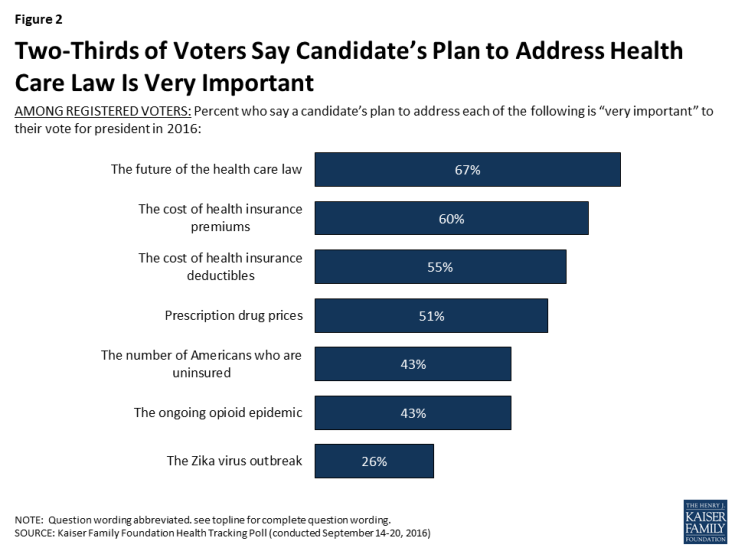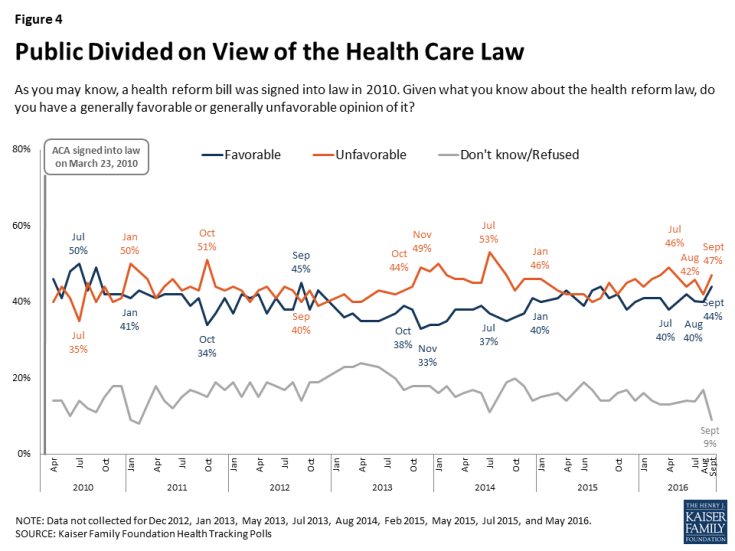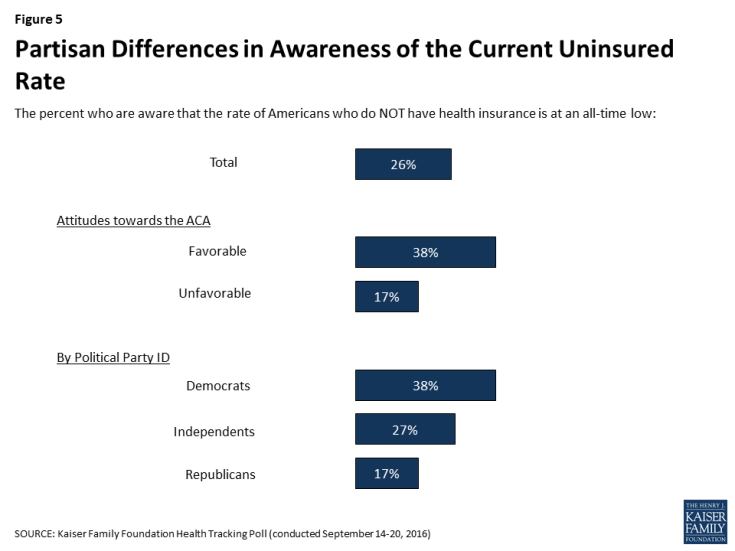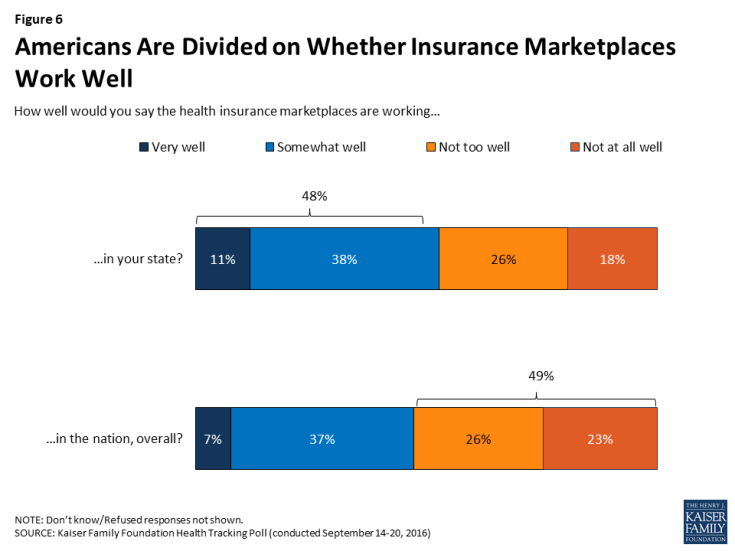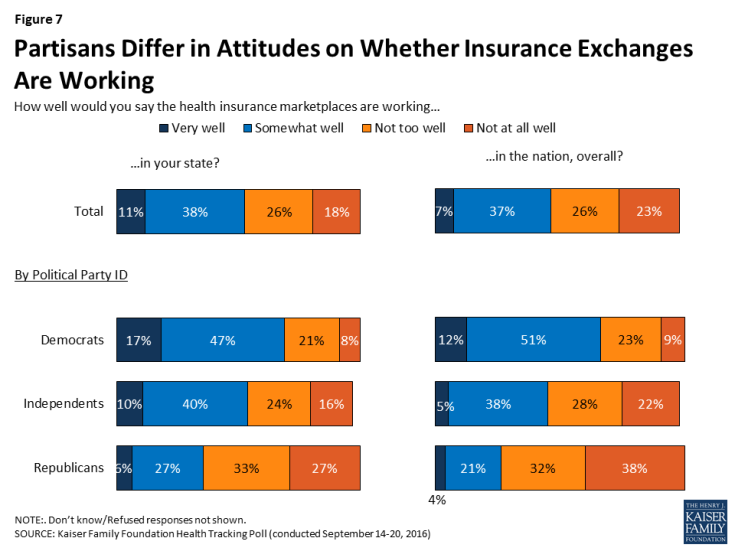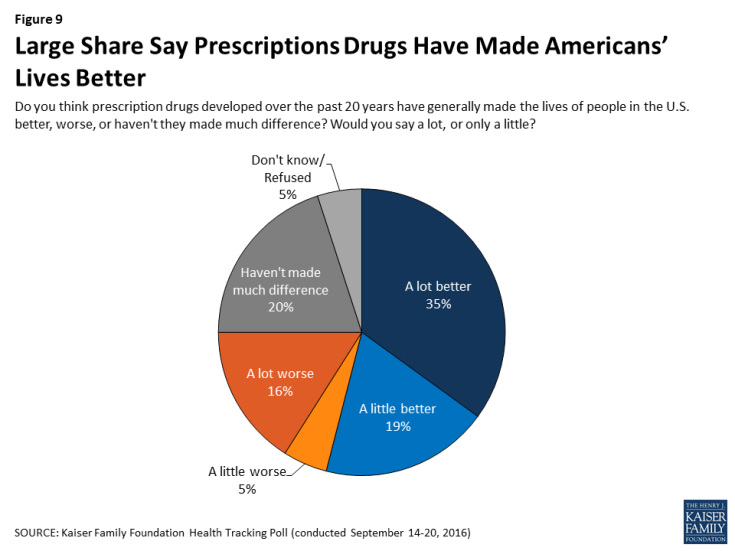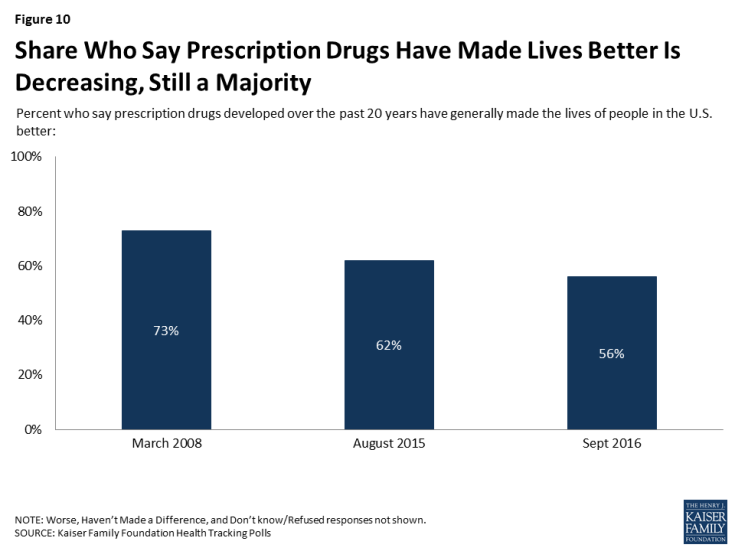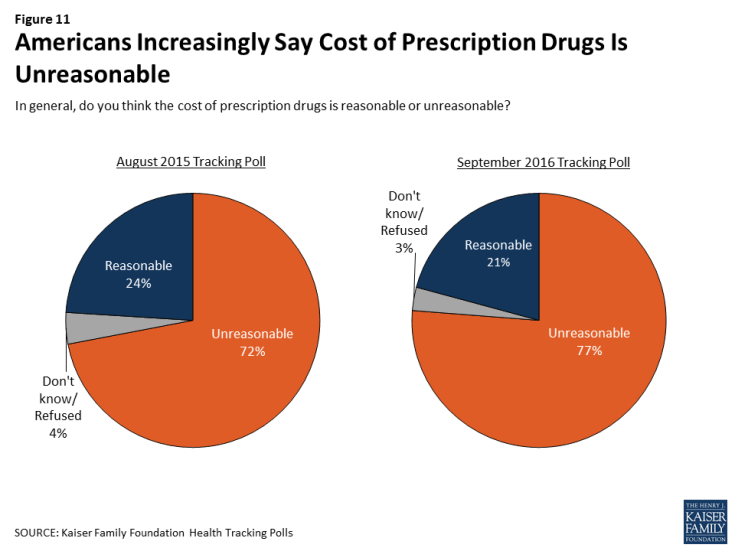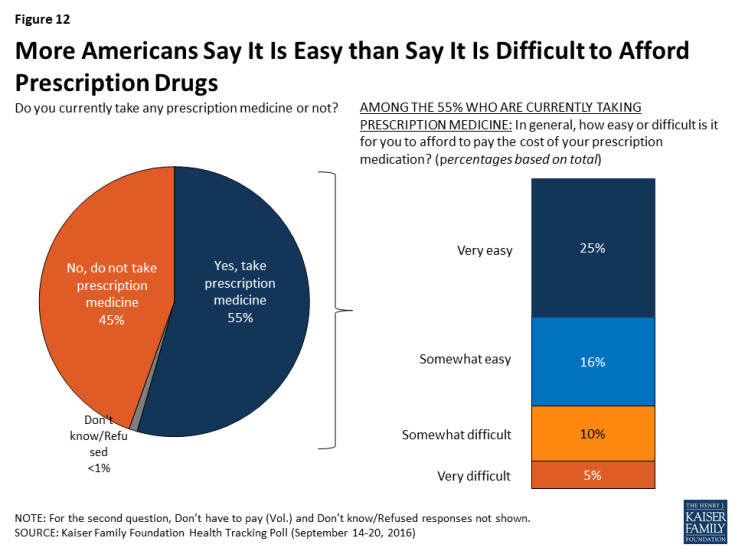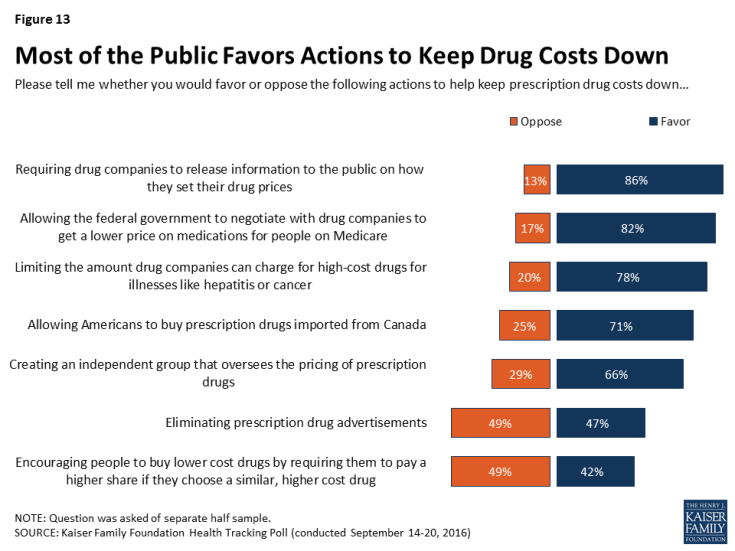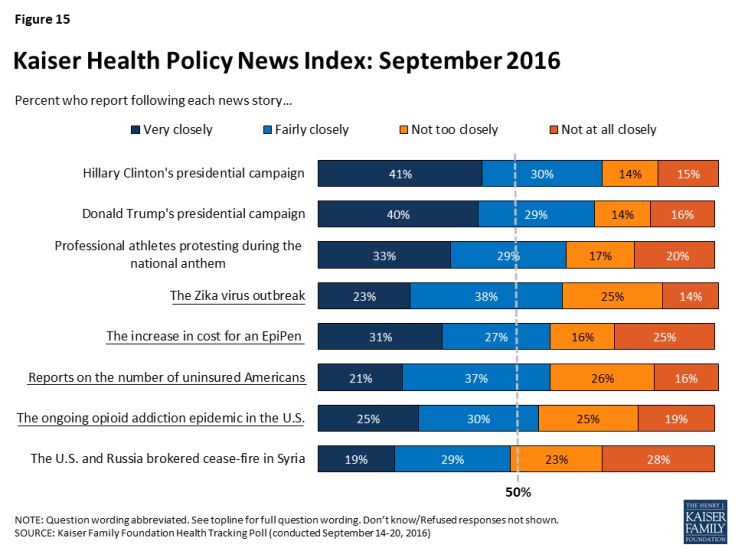Kaiser Health Tracking Poll: September 2016
KEY FINDINGS:
- In the wake of the news about the increase in cost for the Epinephrine injection, the majority (77 percent) of Americans say prescription drug costs are unreasonable, up slightly from 72 percent a year ago. There is widespread support for a variety of actions in order to keep costs down including requiring drug companies to release information to the public on how they set their drug prices, allowing the federal government to negotiate with drug companies to get a lower price on medications for people on Medicare, limiting the amount drug companies can charge for high-cost drugs, allowing Americans to buy prescription drugs imported from Canada, and creating an independent group that oversees the pricing of prescription drugs.
- In deciding which candidate to vote for in the 2016 presidential election, voters are slightly prioritizing the candidates’ personal characteristics over the candidates’ stances on specific issues or the candidates’ political party. While personal characteristics may drive much of the vote choice, when asked about the role that a variety of health care issues will play in the 2016 presidential election, many are salient to voters — including 58 percent of Clinton supporters who say the candidate’s plan to address prescription drug prices will be very important.
- The September Kaiser Health Tracking Poll finds Americans’ opinion of the health care law is divided (44 percent have a favorable view while 47 percent have an unfavorable view).
The 2016 Presidential Election
With less than six weeks before the general election, voters are balancing numerous considerations when deciding which candidate they will vote for in the 2016 presidential election. As polling conducted prior to the first presidential debate shows, a slightly larger share of voters (44 percent) say the candidates’ personal characteristics, including their leadership ability, character, values, and experience, will make the biggest difference in how they vote for president than say the candidates’ stances on specific issues (39 percent) or the candidates’ political party will make the biggest difference (7 percent).
When looking specifically at voters who say they currently plan on voting for Republican presidential nominee Donald Trump, about half (46 percent) say the candidates’ stances on specific issues will make the biggest difference in who they vote for compared to one-third (35 percent) that say the personal characteristics will make the biggest difference. Among voters who are currently supporting Democratic presidential nominee Hillary Clinton, the opposite is true — 53 percent say the candidates’ personal characteristics will make the biggest difference and three in ten (31 percent) say the candidates’ stances on specific issues will make the biggest difference in their vote.
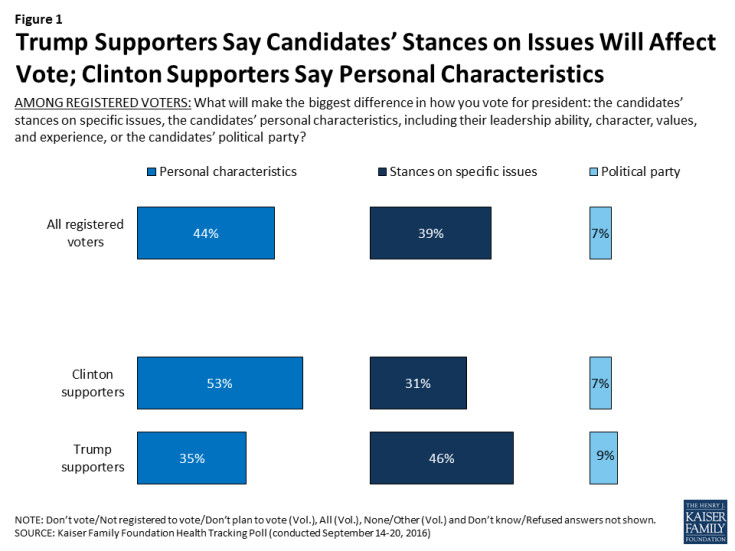
Figure 1: Trump Supporters Say Candidates’ Stances on Issues Will Affect Vote; Clinton Supporters Say Personal Characteristics
Health Care Issues Are Important to Voters
While personal characteristics may drive much of the vote choice, when asked about the role that a variety of health care issues will play in the 2016 presidential election, many are salient to voters. Two-thirds of voters say a candidate’s plan to address the future of the health care law is very important to their vote, six in ten say the same about a candidate’s plan to address the cost of health insurance premiums, 55 percent say the same about a candidate’s plan to address the cost of deductibles, and about half of voters (51 percent) say the same about a candidate’s plan to address prescription drug prices. Smaller shares of voters say a candidate’s plan to address the number of Americans who are uninsured (43 percent), the ongoing opioid epidemic (43 percent), or the Zika virus outbreak (26 percent) is very important to their vote for president.
Health Care Issues More Salient to Clinton Supporters Than Trump Supporters
More Clinton supporters than Trump supporters say a candidate’s plan to address a series of health care issues is very important to their vote, including a candidate’s plan to address the number of Americans who are uninsured (57 percent vs. 28 percent), prescription drug costs, (58 percent vs. 42 percent), the Zika virus outbreak (32 percent vs. 20 percent). Slightly higher shares of Clinton supporters than Trump supporters say a candidate’s plan to address the cost of health insurance deductibles (59 percent vs. 52 percent) and the future of health care law (71 percent vs. 64 percent) is very important. While similar shares of Clinton supporters and Trump supporters say a candidate’s plan to address the cost of health insurance premiums and the ongoing opioid epidemic in the U.S. is very important to their vote for president. To see a side-by-side comparison of the two candidates’ proposed health care policies, please visit KFF’s Snapshot of where Hillary Clinton and Donald Trump Stand on Seven Health Care Issues.
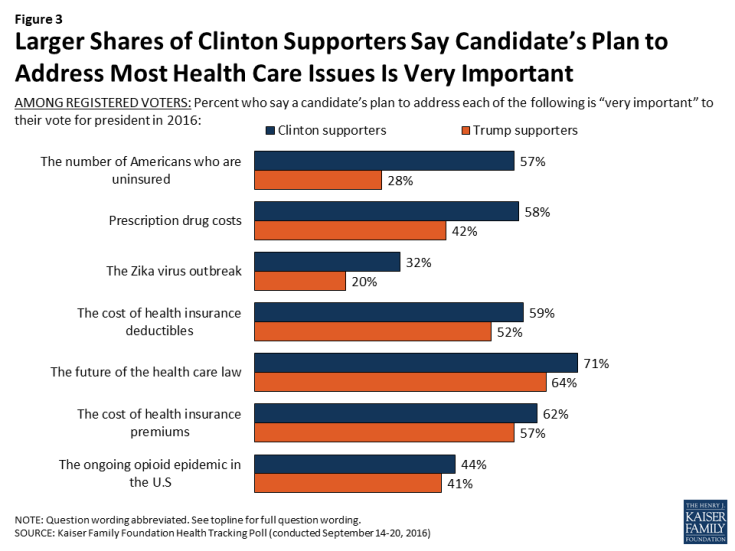
Figure 3: Larger Shares of Clinton Supporters Say Candidate’s Plan to Address Most Health Care Issues Is Very Important
Americans’ Opinions of the Affordable Care Act
With two-thirds of voters saying a candidate’s plan to address the future of the health care law will be very important to their vote for president, the September Kaiser Health Tracking Poll finds Americans’ opinion of the health care law remains divided, with 44 percent saying they have a favorable view and 47 percent saying they have an unfavorable view. The share of individuals who said they “don’t know” whether they have a favorable or unfavorable opinion of the law or refused to answer the question decreased this month from 17 percent in August 2016 to 9 percent in September 2016.
While similar shares of Republicans (7 percent), Democrats (7 percent), and independents (11 percent) currently say they don’t know — or refuse to report — whether they have a favorable or unfavorable opinion of the law, the share of Democrats who don’t know or refuse the question is at its lowest level in four years.
The Number of Americans without Health Insurance
One of the key goals of the 2010 health care law was to reduce the number of Americans who did not have health insurance coverage. According to the U.S. Census, in 2015, 9 percent of Americans went without health insurance coverage — the lowest rate ever recorded.1 When asked whether the rate of Americans without health insurance is at an all-time high or an all-time low, about a quarter (26 percent) of Americans are aware that it is at an all-time low, while one-fifth (21 percent) say that it is at an all-time high and about half (46 percent) say it is about the same as it has been. Awareness of the uninsured rate is mainly viewed through a partisan lens, regardless of how closely Americans are following news about the issue. Four in ten (38 percent) individuals who have favorable attitudes toward the ACA are aware the rate is at an all-time low compared to 17 percent of those with an unfavorable opinion toward the ACA. In addition, 38 percent of Democrats, 27 percent of independents, and 17 percent of Republicans are aware the uninsured rate is at an all-time low. Among those who report they have been following news about this issue “very closely,” similar shares are aware the uninsured rate is at an all-time low (32 percent) as say it is at an all-time high (26 percent).
Health Insurance Marketplaces
In August 2016, health insurer Aetna, Inc. announced it was withdrawing from the ACA exchanges — marketplaces where people who do not have employer-sponsored health insurance can buy coverage. This news was closely followed by about one-third (36 percent) of Americans according to the August Kaiser tracking poll. This month’s poll finds that half of Americans have heard at least some about health insurance marketplaces, which is considerably higher than the share of Americans who reported the same in December 2013 (36 percent).
Americans are divided on how well they think the health insurance marketplaces are working in their own state and in the nation, overall. About half (48 percent) of individuals say the health insurance marketplaces in their own state are working well while 43 percent say they are working either not too well (26 percent) or not at all well (18 percent).
When asked how well they think the marketplaces are working in the nation overall, about half of Americans say they are not working well (26 percent say they are working “not too well” and 23 percent say they are working “not at all well”) while 44 percent say they are working either “very well” (7 percent) or “somewhat well” (37 percent).
Similar to perceptions of the uninsured rate, attitudes towards the health insurance marketplaces also differ among partisans, regardless of how much they have heard about the health insurance marketplaces. Nearly two-thirds of Democrats say the marketplaces in their own state (64 percent) and in the nation overall (62 percent) are working well, while one-third of Republicans say the marketplaces in their own state are working well and 25 percent say the marketplaces in the nation overall are working well. Independents are more divided, with half saying the marketplaces in their own state are working well and 42 percent saying the marketplaces in the nation overall are working well.
In addition, individuals living in states that have developed their own state-based marketplace are more likely to say the health insurance marketplace in their own state is working well — even when controlling for demographic factors that tend to predict support for the ACA (age, income, education level, party identification, gender, and race/ethnicity). Individuals living in states with state-based marketplaces are more positive in their evaluations with 61 percent saying the health insurance marketplace in their state is working either “very” or “somewhat” well. This is similar to the share of those living in states with a state-federal partnership (55 percent) but significantly more positive than those living in states that have not developed their own state-based marketplace and are using the federal marketplace (49 percent).
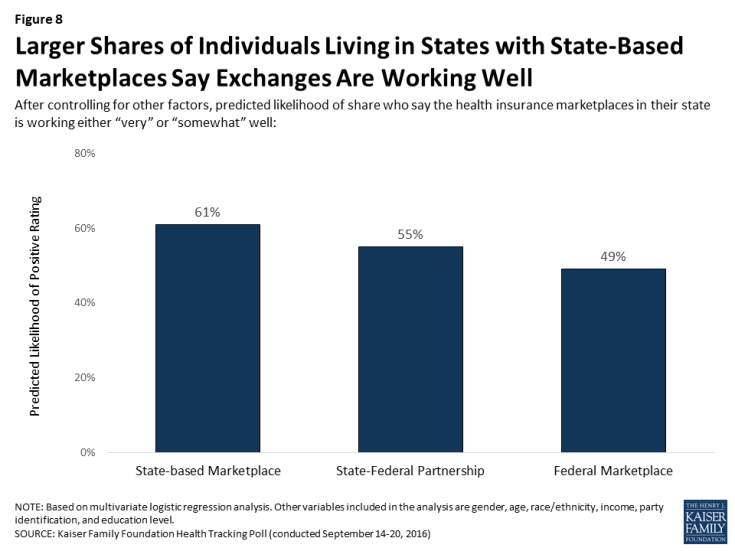
Figure 8: Larger Shares of Individuals Living in States with State-Based Marketplaces Say Exchanges Are Working Well
The Public’s Views On Prescription Drugs
In light of the news about the increase in the cost for the Epinephrine injection and many Clinton and Trump supporters (58 percent and 42 percent, respectively) saying a candidate’s plan to address prescription drug costs is very important to their vote, the September Kaiser Health Tracking Poll takes a look at the public’s attitudes on prescription drugs — in terms of overall benefits as well as methods aimed at curtailing costs.
To see more prescription drug-related poll findings, visit the prescription drug slideshow.
Large Share of Americans Say Prescription Drugs Have Made Lives Better, But Think Costs Are Unreasonable
The majority of the public (56 percent) say prescription drugs developed over the past 20 years have generally made the lives of people in the U.S. better, including about one-third (35 percent) who say prescription drugs have made lives “a lot better.” This is compared to about one in five Americans who say prescription drugs have made the lives of people in the U.S either “a lot worse” (16 percent) or “a little worse” (5 percent), and 20 percent who say prescription drugs have generally not made a difference in people’s lives.
While the majority of Americans say prescription drugs have made lives better, there has been a decrease in the share who say this. In March 2008, 73 percent of Americans said that prescription drugs have made the lives of Americans better, including about half who said they had made lives “a lot better.” In addition, in August 2015, 62 percent of the public said prescription drugs have made the lives of Americans better.
Majority of Americans Say Prescription Drug Costs Are Unreasonable, But Few of Those Taking Prescription Medication Report Problems with Affordability
Costs could be one reason why the share of Americans who say prescription drugs have made the lives of people in the U.S. better is declining. A large majority (77 percent) perceive drug costs as unreasonable while less than a quarter (21 percent) say the costs are reasonable. The share of Americans who say prescription drug costs are unreasonable has increased somewhat over the past year, up from 72 percent in August 2015.
Yet despite the fact that most of the public says prescription drug costs are unreasonable, a large majority of Americans currently taking prescription drugs do not report any difficulty paying for the cost of their prescription medications. Of the 55 percent of Americans who currently take medications, the majority (73 percent) say that affording to pay for the cost of their prescription medicine is easy. Still, 26 percent report difficulty affording their medications (14 percent of the total population).
The ability to afford prescription medication varies widely by reported health status and the number of prescription drugs an individual is taking. Among individuals currently taking prescription medications, a larger share of those who report being in “fair” or “poor” health report difficulty affording their medication (42 percent) than those who report being in “excellent,” “very good,” or “good” health (20 percent). In addition, four in ten individuals (37 percent) who are currently taking four or more medications report difficulty affording them compared to 19 percent of individuals taking prescription medications, but fewer than four.
| Table 1: Those in Worse Health or Taking Four or More Drugs More Likely to Report Difficulty Affording Their Medicines | ||||
| Health Status Among Those Taking Prescription Drugs | Prescription Drug Use | |||
| Excellent/Very Good/Good Health | Fair/Poor Health | Taking 1-3 Prescription Drugs | Taking 4 or More Prescription Drugs | |
| Very easy | 53% | 21% | 56% | 30% |
| Somewhat easy | 26 | 36 | 25 | 33 |
| Somewhat difficult | 15 | 24 | 14 | 22 |
| Very difficult | 5 | 18 | 5 | 14 |
| NOTE: Don’t know/Refused responses not shown. “Don’t have to pay (Vol.)” responses not shown. | ||||
Views of Policy Options to Keep Prescription Drug Costs Down
When presented with a list of policy options intended to help keep the cost of prescription drugs down, the majority of the public is in favor of most of the policy actions, and large shares also believe that the options would be effective in addressing rising drug costs.
The vast majority of Americans favor requiring drug companies to release information to the public on how they set drug prices (86 percent), and eight in ten favor allowing the federal government to negotiate with drug companies to get a lower price on medications for people on Medicare (82 percent) and limiting the amount drug companies can charge for high-cost drugs for illnesses like hepatitis or cancer (78 percent). In addition, 71 percent favor allowing Americans to buy prescription drugs imported from Canada and two-thirds (66 percent) favor creating an independent group that oversees the pricing of prescription drugs — a policy proposal put forth by Democratic presidential candidate Hillary Clinton in response to the EpiPen controversy.2 On the other hand, Americans are split on two potential policy actions: eliminating prescription drug advertisements and encouraging people to purchase lower cost drugs by requiring them to pay a higher share if they choose a similar, higher cost drug.
In addition, a majority of Americans also believe most of the proposed policies would be effective in keeping prescription drug costs down. Somewhat fewer, but still half, say eliminating prescription drug advertisements (51 percent) and encouraging people to buy lower cost drugs by requiring them to pay a higher share if they choose a similar, higher cost drug (51 percent) would be effective.
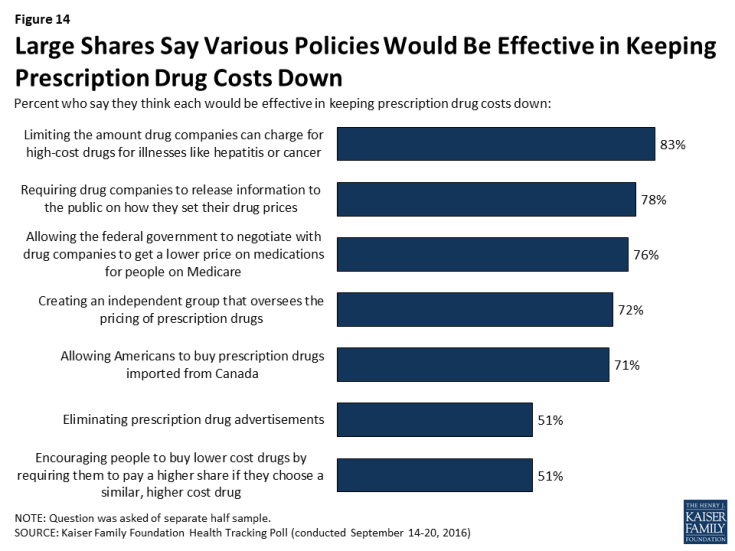
Figure 14: Large Shares Say Various Policies Would Be Effective in Keeping Prescription Drug Costs Down
A majority of Republicans, Democrats, and independents both favor and think most of these policy actions would be effective in keeping prescription drug costs down, with the exception of two potential actions: eliminating prescription drug advertisements and encouraging people to buy lower cost drugs by requiring them to pay a higher share if they choose a similar, higher cost drug. Fewer partisans favor either of these policy actions.
| Table 2: Views of Policy Actions to Keep Drug Costs Down by Party Identification | |||
| Percent who say they favor each of the following and percent who say they think each would be effective in keeping prescription drug costs down: | Party ID | ||
| Democrats | Independents | Republicans | |
| Requiring drug companies to release information to the public on how they set their drug prices | |||
| Favorable | 83% | 88% | 88% |
| Effective | 82% | 75% | 78% |
| Allowing the federal government to negotiate with drug companies to get a lower price on medications for people on Medicare | |||
| Favorable | 93% | 85% | 68% |
| Effective | 87% | 81% | 65% |
| Limiting the amount drug companies can charge for high-cost drugs for illnesses like hepatitis or cancer | |||
| Favorable | 79% | 83% | 73% |
| Effective | 92% | 81% | 79% |
| Allowing Americans to buy prescription drugs imported from Canada | |||
| Favorable | 66% | 77% | 70% |
| Effective | 72% | 76% | 74% |
| Creating an independent group that oversees the pricing of prescription drugs | |||
| Favorable | 72% | 65% | 60% |
| Effective | 79% | 72% | 65% |
| Encouraging people to buy lower cost drugs by requiring them to pay a higher share if they choose a similar, higher cost drug | |||
| Favorable | 39% | 45% | 37% |
| Effective | 57% | 52% | 56% |
| Eliminating prescription drug advertisements | |||
| Favorable | 44% | 49% | 44% |
| Effective | 53% | 51% | 52% |
| NOTE: Questions were asked of separate half samples. | |||
Kaiser Health Policy News Index: September 2016
The September Kaiser Health Tracking Poll finds the 2016 presidential campaign dominating the public’s attention, with the majority of Americans closely following stories about Hillary Clinton’s presidential campaign (70 percent) and Donald Trump’s presidential campaign (69 percent). About six in ten Americans report closely following several health policies news stories during the past month including the Zika virus outbreak (61 percent), the increase in cost for the Epinephrine injection, commonly known as the EpiPen (58 percent), and the reports on the number of uninsured Americans (58 percent). This is similar to the share who say they are following the stories about professional athletes, like NFL player Colin Kaepernick, protesting during the playing of the national anthem (62 percent). A majority of the public also say they are following news about the ongoing heroin and prescription painkiller addiction epidemic in the U.S. (56 percent). About half of the public (49 percent) say they are following news about the U.S. and Russia brokered cease-fire in Syria, which began on September 12th.3

